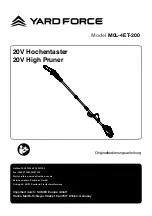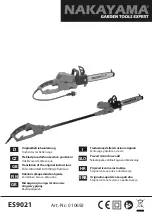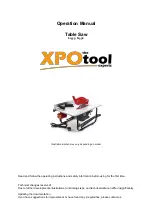
24
ENGLISH
3.
Tilt the motorhead slowly into the
desired position.
3
Note:
The track arm holder engages at
positive stops at the 0°, 22.5°, and 45°
position.
4.
Tighten the sawhead tilt locking
lever.
5.
Cut workpiece as detailed under
"Standard cross cuts".
8.4 Compound mitre cuts
3
Note:
The compound mitre cut is a
combination of mitre and bevel cut. This
means the workpiece is cut at an angle
other than 90° against the rear guide
edge
and
against its surface.
A
Danger!
When cutting compound mitres the
saw blade is much more exposed
than normally - increased risk of
injury. Always keep sufficient dis-
tance to the saw blade.
Maximum workpiece cross section
(dimensions in mm):
Starting position:
−
Sawhead fully raised.
−
Cutting depth limiter set to maxi-
mum depth of cut.
−
Rotating table locked in desired
position.
−
Sawhead tilted to desired angle
against the workpiece's surface and
locked.
−
If the sawhead is to be tilted
between 22.5 ° and 48° to the right,
swing the hinged fence down.
−
Locking screw of the track arm loos-
ened.
−
Track arm not extended.
Cutting the work piece:
•
Cut workpiece as detailed under
"Standard cross cuts".
8.5 Grooving
3
Note:
Together with the track arm, the
cutting depth limiter makes grooving
possible. With grooving no parting cut is
made, but the workpiece is cut to a cer-
tain depth only.
A
Risk of kickback!
When grooving it is especially impor-
tant no lateral pressure is applied to
the saw blade. Otherwise the saw-
head may be kicked up abruptly! Use
a stock clamp when grooving. Avoid
lateral pressure on the sawhead.
Starting position:
−
Sawhead fully raised.
−
Sawhead tilted to desired angle
against the work piece's surface and
locked.
−
Rotating table locked in desired
position.
−
Locking screw of the track arm loos-
ened.
−
Track arm not extended.
Cutting the work piece:
1.
Adjust cutting depth limiter
desired cutting depth and secure
setting with locking nut.
2.
Hold workpiece against the fence.
3
Note:
For the groove to be cut at the
desired depth across the whole work-
piece width, a suitable spacer strip
needs to be placed between workpiece
and fence.
3.
Push the safety lock to the side and
press and hold the ON/OFF switch.
4.
Slowly swing the sawhead fully
down, holding the handle firmly.
When sawing, exert only moderate
pressure to prevent the motor speed
to drop too much.
5.
When sawing, pull sawhead forward
(towards the operator).
6.
Groove workpiece in a single pass.
7.
Release the ON/OFF switch and let
the sawhead slowly return to its
upper starting position.
8.6 Auxiliary Fence
3
Note:
Use the auxiliary fence when
making vertical cuts in work pieces
higher than the saw's fence. Bevel cuts
are only possible without the auxiliary
fence in place.
Installing the auxiliary fence:
1.
Put washers on carriage bolts
.
2.
Slide carriage bolts
into fence
extrusions.
Width with sawhead tilted approx.
22.5 °
left
22.5 °
right
48 °
left
48 °
right
Ro
ta
ti
ng ta
ble
po
sition
15°
288
288
288
288
22.5°
275
275
275
275
30°
257
257
257
257
45°
210
210
210
210
50°
190
190
190
190
60°
right
148
148
148
148
Height with sawhead tilted approx.
22.5 °
left
22.5 °
right
48 °
left
48 °
right
Rotating
tab
le
positio
n
15°
70
65
45
20
22.5°
70
65
45
20
30°
70
65
45
20
45°
70
65
45
20
50°
70
65
45
20
60°
right
70
65
45
20
53
54
















































